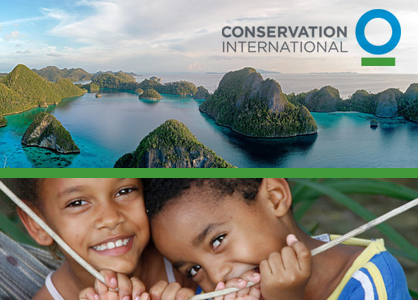Conservation International: Working to save our planet
The future of our planet is hanging in the balance, and Conservation International knows it.
Believing that the environmental challenges facing our world have never been greater, Conservation International aims to create a healthy yet productive world in which we are dedicated to caring for and valuing nature, preserving our world for generations to come. Through science, policy and field work, CI attacks our ecological problems at every level, from the local community to major governments, bringing to bear innovative solutions to pressing issues.
“It’s not a question of can I conserve nature. (Communities) need these resources, they need the fish, they need to be farmers and live off the land. And so how do we make it productive for them while helping them conserve these resources?” Cynthia McKee, senior vice president of development, said of their programs.
Conservation International was founded in 1987 by a small yet committed group of conservationists who were concerned with protecting biodiversity. Now about to celebrate its 25th anniversary, the charity employs 900 staff members working in 30 countries.
Partnership is both their hallmark and the reason for much of their success. Boasting more than 1,000 partners, CI works by bringing everyone together at every level to figure out what needs to be done and then to create that action.
“There are folks that work at the level of helping to influence decision-makers at the government level, and we have people on the ground working in the field working with the local stakeholders,” McKee said. “It’s about being a key member at the table to map out what needs to be protected, what’s possible, and getting everyone to buy in and be part of the process.”
And they have been busy at this endeavor, having safeguarded more than 500 million acres of critical land and oceanscapes, protecting huge swaths of areas that can even be seen in space. CI is also involved in a range of other programs to help our world, from protecting fresh water and reducing green house emissions to assuring plentiful food and minimizing environmental pressures on human health.
“People need nature to thrive,” McKee said. “From the air we breathe to the food we eat to the water we drink, it’s all intrinsically linked.”
At Conservation International, they use creative financing mechanisms and leverage resources to bring people into conservation. Along the way, they partner with some interesting bedfellows. Entities involved range from groups such as UNICEF or the Gates Foundation to various levels of government and companies like Starbucks and McDonalds.
Sometimes even oil companies, which McKee says are not too popular to work with, make the list. “But we’re all in it together,” she pointed out. “We can’t do it alone. We need partners. We want partners.”
The organization is not afraid to take a cold, hard look at its impact.
“We said ‘it’s not enough.’ The rate of extinction of species is escalating. The population is going to grow exponentially. How do we make conservation relevant to humans and human health and well-being? How do we make our work relevant to governments as they are thinking through development, to corporations as they are thinking where to extract oil or mine?”
One recent success came from eight years of hard work in Costa Rica. After collaborating with foreign governments, the Costa Rican government and local stakeholders, they were able to preserve a critical marine habitat, home to sharks, sea turtles, elephant tuna and more. The resulting protected area was larger than Yellowstone National Park. The accomplishment is extraordinary, but McKee reports they often deal in this scale.
Yet in the face of the overwhelming environmental issues we confront in our world today, much more remains to be done. “No matter how much work we have being doing, it just seems we’re against the clock,” McKee said. “And so you continually have to think … What’s a smarter way?”
Their biggest challenge, however, may not just be the bewildering array of environmental problems, but also how to fund the important work they do.
One specific yet digestible way to help is the Protect an Acre or Save a Mile of Ocean programs. We are dependent on the habitats, animals and systems of our oceans, yet they face challenges such as pollution and overfishing. For just $75, you can save a mile of ocean for one year. Or you could elect to work toward eliminating climate change and to stop the slashing and clearing of our forest by protecting acres for $15 each.
“It may seem daunting to people,” McKee said. “We do all these things. But there are ways that people can get involved, and that’s through behavioral changes, that’s recycling and patronizing companies that practice sustainable sourcing, spreading awareness of the issues and donating to support our work.”
For more information or to support them in their work, visit www.conservation.org.
Tagged in: lux exclusives, charity, eco, nonprofit, philanthropy, organization, environment, earth, conservation international, planet, ci,

PurpleNeon/Conservation International via Sterling Zumbrunn/ Peter Stonier



